Opinion: "Sleep invisibles" offer a window into your health

(Image Credit: iStockPhoto/PeopleImages)
Sleep has long been and – to a great extent – still is the most commonly overlooked necessity of life. Like the air we breathe, the water that sustains us and the food that nourishes us, sleep is critical to our health and well-being. Yet, it is the one commodity that few of us have enough of and, too often, is the first thing sacrificed in our hectic lives.
This Friday, we celebrate World Sleep Day, a global initiative reminding us to take better control of our sleep – and by extension our overall health. But how can we achieve better sleep and health?
Over the last few years, new wearable devices have helped increase awareness and interest in personal health monitoring. We can now easily track our daily activities, workouts, calories burned and we can actually enjoy doing so.
Still, the best time to monitor our health is at night, while we are asleep. Sleep provides a unique, accurate window to our health with unparalleled accuracy and convenience.
In the same way that wearables have enhanced many people’s daily wellness routines, new sleep monitoring devices are raising the bar for home health. Gaining access to a previously untapped arsenal of information, these devices track our sleep patterns and vitals to provide crucial insight into our overall health.
While all of us can benefit from such monitoring to manage our health, it is especially important for the elderly, the very young, and those with chronic conditions – who are at their most vulnerable when alone at night.
Below are several advantages of some of the new home sleep sensors:
- Contact Free: Today, solutions exist to monitor sleep without the need to wear clunky devices or wires on our bodies. Instead, systems that measure vital signs are placed under a mattress and automatically record data without us ever feeling them. With this convenience, even those who tend to forget to take care of their health are still 100% covered. These non-invasive sensors are the next generation of wearables, also known as ‘health invisibles’.
- Accurate: Sleep sensors can detect an average 50,000 data points every night, tracking our breathing, cardiovascular parameters, sleep stages and general stress. This provides a thorough and precise picture of our overall health. Moreover, with our bodies at rest, our heart and respiratory rates are completely repeatable from one night to the next, to within less than one heartbeat per-minute. This builds a clear baseline in which fluctuations can be quickly and accurately detected and translates into fewer false readings.
- Advance Warning: Fluctuations or abnormal readings can provide advance warning of a heart attack or detect potentially serious disorders such as sleep apnea. Though nighttime is the most dangerous time for cardiovascular events to occur, these sensors are also effective in detecting early warning signs for events that may take place the following day. Therefore, monitoring ourselves at night provides a safety net for these events, as automatic alerts can enable family or caregivers to take proactive steps at the most important time.
- Clinically Proven: There is an ongoing debate about the accuracy of health trackers, as many are not backed by medically-proven technology. Consider the recent lawsuits against Fitbit, for example. However, some technologies that have been clinically proven in hospitals and sleep labs are now making their way to the market. Technologies that have been be used by hospital professionals can certainly be relied upon in the home environment. They are a better choice when it comes to accuracy.
- Better Sleep: 8 or 9 hours on your Tempurpedic might sound like great sleep, but many people are unaware of the actual length or quality of their sleep. Many of us underestimate or overestimate the time we actually sleep. Smart, automatic sensors can learn our true patterns and provide tips to improve our sleep and health.
- No More Charging: One of the key challenges of health wearables is battery life and the inconvenience of constant charging. However, sensors placed under a mattress don’t require any charging. Once they are set they can be used for years with hardly any upkeep and no daily setup or hassle.
New sleep monitors go far beyond just sleep, they enable us to be better informed and empowered to manage our personal health. That these solutions do not inconvenience our lives is equally important. Sleep sensing provides a crucial window of opportunity to improve overall health and fitness. New technologies allow us to take advantage of this opportunity and turn our bed into a friendly and proven net of safety and health. Here’s to a happy World Sleep Day.
Are you impressed with current sleep wearables? Let us know in the comments.
 Interested in hearing industry leaders discuss subjects like this and sharing their IoT use-cases? Attend the IoT Tech Expo World Series events with upcoming shows in Silicon Valley, London and Amsterdam to learn more.
Interested in hearing industry leaders discuss subjects like this and sharing their IoT use-cases? Attend the IoT Tech Expo World Series events with upcoming shows in Silicon Valley, London and Amsterdam to learn more.
The show is co-located with the AI & Big Data Expo, Cyber Security & Cloud Expo and Blockchain Expo so you can explore the entire ecosystem in one place.

Leave a comment
Alternatively
This will only be used to quickly provide signup information and will not allow us to post to your account or appear on your timeline.